Main Article Content
Abstract
Keywords
Article Details
Under the following term:
-
Attribution — You must give appropriate credit, provide a link to the license, and indicate if changes were made. You may do so in any reasonable manner, but not in any way that suggests the licensor endorses you or your use.
-
ShareAlike — If you remix, transform, or build upon the material, you must distribute your contributions under the same license as the original.
- No additional restrictions — You may not apply legal terms or technological measures that legally restrict others from doing anything the license permits.
References
- Bowles, J. E. (1996). "Foundation Analysis And Design", 5th edition. McGraw-Hill.
- Badan Standarisasi Nasional. (2004). "RSNI T-12-2004 Perencanaan Struktur Beton Untuk Jembatan". Jakarta.
- Badan Standarisasi Nasional. (2005). "RSNI T-03-2005 Perencanaan Struktur Baja Untuk Jembatan". Jakarta.
- Badan Standarisasi Nasional. (2016). "SNI 1725:2016 Pembebanan untuk Jembatan". Jakarta.
- Badan Standarisasi Nasional. (2016). SNI 2833:2016 Perencanaan Jembatan Terhadap Beban Gempa. Jakarta.
- Canadian Standards Association. (2006). "CSA-S6-06 Canadian Highway and Bridge Design Code". Mississauga.
- Corrugated Steel Pipe Institute. (2007). "Handbook of Steel Drainage and Highway Construction Products" (2nd ed.). Ontario.
- Kementerian PUPR. (2015). "Surat Edaran Menteri PU No.41-46/SE/M/2015 tentang Pedoman Spesifikasi Material Ringan untuk Konstruksi Jalan". Jakarta.
- Midasoft, inc. (2006). "Analysis for Civil Structures". Midasoft.
- PLS2, S. (2019). "Youtube Pembangunan Overpass JPL 482 Pucung Lor Kroya". Dipetik Maret 15, 2021, dari https://www.youtube.com/watch?v=BOhQBmydG5U
- Pusat Litbang Jalan dan Jembatan PUPR. (2016). "Teknologi Corrugated Mortar Busa Pusjatan (CMP)". Jakarta.
- Pusat Litbang Jalan dan Jembatan PUPR. (2017). "Aplikasi Lini Beta Pusjatan". Dipetik Maret 15, 2021, dari http://petagempa.pusjatan.pu.go.id/
References
Bowles, J. E. (1996). "Foundation Analysis And Design", 5th edition. McGraw-Hill.
Badan Standarisasi Nasional. (2004). "RSNI T-12-2004 Perencanaan Struktur Beton Untuk Jembatan". Jakarta.
Badan Standarisasi Nasional. (2005). "RSNI T-03-2005 Perencanaan Struktur Baja Untuk Jembatan". Jakarta.
Badan Standarisasi Nasional. (2016). "SNI 1725:2016 Pembebanan untuk Jembatan". Jakarta.
Badan Standarisasi Nasional. (2016). SNI 2833:2016 Perencanaan Jembatan Terhadap Beban Gempa. Jakarta.
Canadian Standards Association. (2006). "CSA-S6-06 Canadian Highway and Bridge Design Code". Mississauga.
Corrugated Steel Pipe Institute. (2007). "Handbook of Steel Drainage and Highway Construction Products" (2nd ed.). Ontario.
Kementerian PUPR. (2015). "Surat Edaran Menteri PU No.41-46/SE/M/2015 tentang Pedoman Spesifikasi Material Ringan untuk Konstruksi Jalan". Jakarta.
Midasoft, inc. (2006). "Analysis for Civil Structures". Midasoft.
PLS2, S. (2019). "Youtube Pembangunan Overpass JPL 482 Pucung Lor Kroya". Dipetik Maret 15, 2021, dari https://www.youtube.com/watch?v=BOhQBmydG5U
Pusat Litbang Jalan dan Jembatan PUPR. (2016). "Teknologi Corrugated Mortar Busa Pusjatan (CMP)". Jakarta.
Pusat Litbang Jalan dan Jembatan PUPR. (2017). "Aplikasi Lini Beta Pusjatan". Dipetik Maret 15, 2021, dari http://petagempa.pusjatan.pu.go.id/
